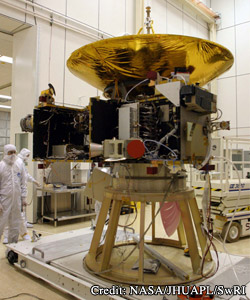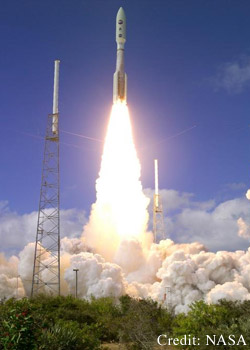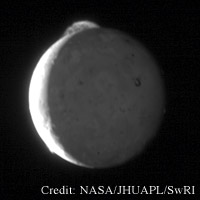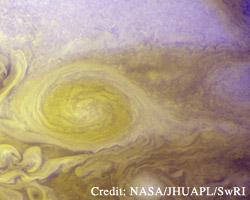
New FrontiersNew Frontiers
SUMMARY: The New Frontiers Program is a scientific endeavor designed to explore the entire solar system by launching missions every 36 months. The first of these missions, New Horizons, was launched in January 2006 and will explore Pluto, its moons, and other Kuiper belt objects when it arrives in 2015. The next of these missions, Juno, is scheduled to launch in 2011 and will map Jupiter's magnetic fields, atmospheric composition, and gravity as it repeatedly orbits the gas giant in 2016.
The New Horizons Spacecraft
Juno: NASA's New Frontiers Mission to Jupiter
Related links
Related Lessons:
Charting the Progress of New Horizons
Growing Up With a Mission
Looking to the Future
Where Are We Going?
Is There Life on Earth?
The New Horizons Spacecraft
- Launch Date: 19 January 2006
- Mission: Study Pluto and its satellites, Explore the Kuiper belt
- Jupiter Gravity Assist: February 2007
- Scheduled Pluto-Charon Encounter: July 2015
- Scheduled Kuiper Belt Object Encounters: 2016-2020
Pluto will be the first dwarf planet to be visited by a spacecraft. Neither a terrestrial planet nor a gas giant, New Horizons seeks to find out more about the former ninth planet and its origin. Pluto and its largest moon Charon form a binary planet, the only known binary system in our solar system. They are among the largest objects in the Kuiper belt and belong to a category known as ice dwarfs. An ice dwarf has a solid surface but much of its mass is made up of icy material.
On its path to Pluto, New Horizons will use Jupiter for a gravity assist, as well as for scientific observations. New Horizons will study Jupiter's magnetosphere, take a look at Jupiter's atmosphere and storms, observe Jupiter's rings and make more accurate measurements of the atmosphere and composition of Jupiter's satellites.
On 1 March 2007, this image was captured of a giant plume from Io's Tvashtar volcano that extends 330 km above the moon's surface.
This image combines high-resolution images sent from New Horizons with color images taken by HST. The Little Red Spot, shown, is the second largest storm on Jupiter and is roughly 70% the size of the Earth.

The New Horizons spacecraft at the
Johns Hopkins University
Applied Physics Laboratory
(click to enlarge)
Students at the University of Colorado had a unique opportunity to participate in the New Horizons mission. The Student Dust Counter (SDC) is a secondary science payload attached to the New Horizons spacecraft. Designed entirely by university students, SDC's primary mission is to map the dust density distribution in the solar system. Second, it seeks to understand the variation in distribution of different sized particles. The third goal is to determine how fast the Kuiper belt produces dust. Success in all of these goals will establish whether the current theory of solar system formation is accurate.
NEW HORIZONS: MISSION OBJECTIVES
- • Map surface composition of Pluto and Charon
- • Characterize the atmosphere of Pluto
- • Search for an atmosphere around Charon
- • Determine surface temperature of Pluto and Charon
- • Search for rings and additional satellites around Pluto
New Horizons will be closest to Pluto and Charon in 2015. Plans to observe Pluto's other 2 moons, Nix and Hydra, will be made after further observations of the moon's orbits. The extended mission includes one or two encounters of Kuiper Belt Objects (KBOs).
Juno: NASA's New Frontiers Mission to Jupiter

In the year 2016 the Juno spacecraft will enter into orbit around Jupiter. This mission is the second unmanned visit to the mysterious gas giant. It will orbit from pole to pole in order to avoid systems of charged particles trapped in Jupiter's magnetic field. This solar powered spacecraft will use infrared and microwave instruments to probe deep within the atmosphere. It will help scientists to understand more about the location and abundance of oxygen and water. Juno will use other instruments to measure Jupiter's magnetic and gravitational fields in order to understand its amazing auroras and the complex structure that is hidden by the immense clouded atmosphere. This mission will help to fill in missing pieces of the puzzle of Jupiter's true composition.
Visit the official Juno home page.
More images taken by New Horizons
The Official New Horizons web site
The Official Student Dust Counter web site
Where is New Horizons now?




